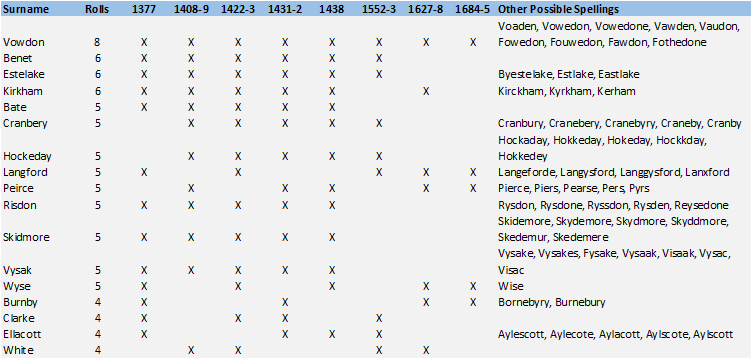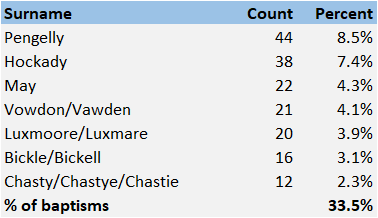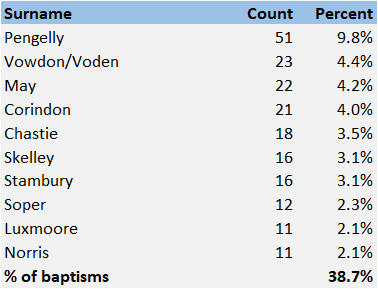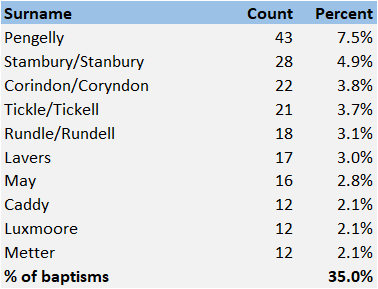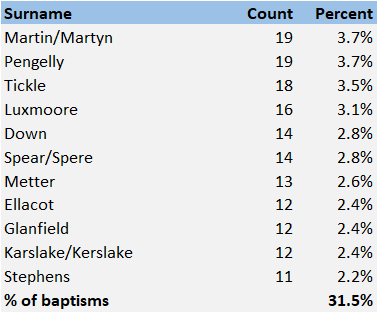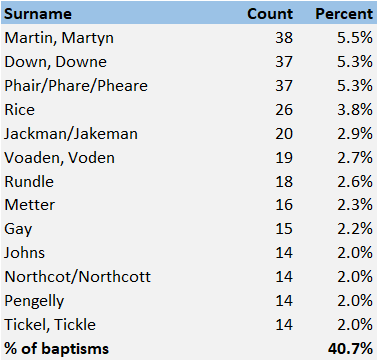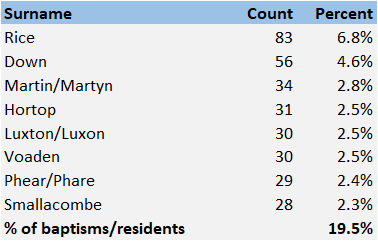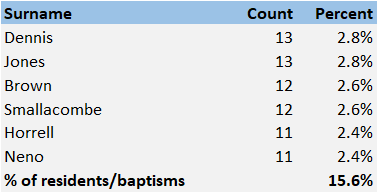Bratton Clovelly Surnames, 1555-1950
The purpose of this study is to identify the most frequent surnames in Bratton Clovelly through the centuries. The following sources have been used:
- Bratton Clovelly Manor Rolls 1377-1684
- Bratton Clovelly St Mary’s Church of England Baptisms 1555-1839 & 1940-1950
- Bratton Clovelly Censuses 1841-1921
- Bratton Clovelly 1939 Register
- Bible Christian Northlew Circuit Baptisms 1940-1950
- Bible Christian Launceston Circuit Baptisms 1940-1950
These sources were chosen based on the sources currently available that best represent the total Bratton Clovelly population through time, rather than specific groups such as landowners. However, the sources have significant limitations and can only provide indicative statistics:
- Only 10 manor rolls survive for the parish, 8 of which contain surnames. There is only one roll from the 14th century and similarly for the 16th and 17th centuries, although baptism registers are available by the time of the last manor roll in 1684-1685. There are four rolls in the first half of the 15th century. Adults, both men and women, could attend the manor court sessions, of which about 60 sessions are contained in the rolls. Surname frequency cannot be determined from this sparse sample but the rolls do contain many surnames and persistence of these names in the rolls are shown.
- Baptism registers only represent Bratton Clovelly residents born in the parish. There were likely to have been many residents born elsewhere.
- Baptism registers only represent those who had children and those who baptised their children. Since marriage rates were very high and nonconformity was still in its early days in the parish before the 1841 census, this limitation may not have been of much significance. It would have been significant in the period 1840 to 1950.
- Census records include all residents of the parish but are only available from 1841 to 1921.
- The 1939 Register is also a listing of all residents but as of 2025, about 30 records were still redacted due to privacy laws.
Accepting the limitations of the data, these sources still offer a remarkably detailed glimpse of the families who lived in Bratton Clovelly for over 600 years.
The chart below identifies the surnames that appeared in at least 5 of the 8 surviving manor rolls with surnames. Only one surname with modern spelling Voaden (and many other spellings in the rolls) appears in all 8 of the rolls. In addition, the Voaden surname continues to appear in every century into the 20th century, the most persistent surname in the parish. Higher Voaden and Lower Voaden Farms still operate today in the middle of the parish.
The charts below show the surnames that accounted for at least 2% of the given sample from the start of parish registers in 1555 to 1950. They show that Bratton Clovelly remained a diverse community, with the large majority of the parish holding surnames that occurred infrequently. A small number of surnames exceeded 5% of the sample through the centuries but none reached 10%. New prevalent surnames appeared in every period and as sources for surnames became more inclusive, diversity appears to be much higher than indicated by the earlier baptism registers.
